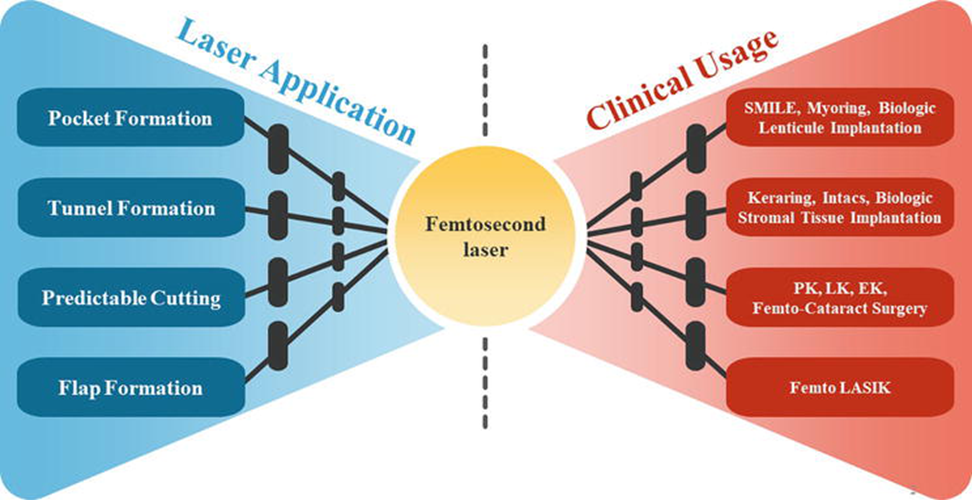FROM THE MARRIAGE OF PHYSICS AND BIOLOGY EMERGED A TECHNOLOGY THAT HAS REVOLUTIONISED OPHTHALMOLOGY – LASER
Relevance: GS – 3 : Science and Technology – developments.
Why in the news?
- Ophthalmologists, who are experts in the physiology of the eye, often do not have time to study laser physics in depth.
- Despite this, the combination of physics and ophthalmology has led to significant advances in vision correction, especially for refractive errors and cataract surgery
- The femtosecond laser surgery, raises the question of how these two seemingly unrelated fields—laser physics and optical biology—combined to revolutionize vision correction.
The Development of Laser Technology
- The word ‘laser’ stands for ‘Light Amplification by Stimulated Emission of Radiation.’ This term reflects the core physics behind laser technology.
- Albert Einstein introduced the concept of stimulated emission in 1917.
- In the excited state, the electron can fall to a lower energy state and release energy in the form of photons.
- This photon can interact with another excited electron and trigger the release of a second photon.
- The second photon has the same energy, phase, and direction as the first.
- The result of this process is luminosity enhancement or light.
- Practical Realization:
- The theory was first practically realized in 1960 by Theodore Maiman, a physicist at Hughes Research Laboratories.
- Maiman built the first working laser using a ruby crystal as the gain medium.
- The ruby laser emitted light at a wavelength of 694 nm, in the red part of the spectrum.
- It was the first device to produce a concentrated beam of light with unique properties such as coherence, monochromaticity, and the ability to be focused to a very small spot.
Chirped pulse amplification (CPA) and its impact on ophthalmology
- The development of the CPA: In the 1980s, Gerard Mauro and his student Donna Strickland developed chirped pulse amplification (CPA) while working at the University of Rochester.
- CPA revolutionized laser physics by enabling ultrashort laser pulses to be amplified without destroying the catalyst.
- This innovation earned Mauro and Strickland the 2018 Nobel Prize in Physics.
- Despite physicists’ limited knowledge of ocular physiology, CPA has become an important tool in ophthalmic surgery.
- The relationship between laser physics and ophthalmology began with an accidental discovery.
- A research assistant in Mauru’s laboratory was accidentally struck in the eye by a laser beam when he was not wearing protective glasses.
- After seeing an ophthalmologist, the doctor noticed the exact damage to the eye and wanted to know what the laser looked like.
- The ophthalmologist was impressed by the ‘perfect’ or even damage observed around the retina.
- This unusual discovery prompted an in-depth investigation into the capabilities of lasers. This curiosity and research eventually led to the development of femtosecond ophthalmology
- Innovation across disciplines:
- A chance interaction between a curious physician and a physicist looking for practical applications has blurred the line between laser physics and ophthalmology
- CPA has enabled laser pulses to be precisely amplified, making them ideal for medical applications such as eye surgery, where high accuracy is required.
- CPA-Based Lasers in Femtosurgery: CPA-based lasers are integral to modern femtosurgery procedures, including refraction correction.
- These lasers emit ultrashort pulses of light, lasting only a few quadrillionths of a second, ensuring extraordinary precision.
- The high-intensity pulses allow for precise cornea reshaping with minimal damage to surrounding tissues, leading to better patient outcomes and faster recovery times.
Transforming Ophthalmology with CPA-Based Lasers
- Impact on Cataract Surgery: CPA-based lasers have also revolutionized cataract surgery, one of the most common surgical procedures worldwide.
- Traditional cataract surgery involves manual incisions and ultrasonic energy to break up the cloudy lens.
- In laser-assisted cataract surgery, a femtosecond laser creates precise incisions and softens the lens, reducing the need for ultrasonic energy.
- This results in more accurate placement of the artificial intraocular lens (IOL), improved precision, safety, and faster recovery times.
- Femtosecond Laser Technology: The femtosecond laser is an infrared laser with a wavelength of 1053 nm, known for its precision in eye surgeries.
- It generates tiny, rapid bursts that break apart tissue without damaging surrounding areas.
- Compared to the Nd laser, which operates in nanoseconds (10-9), the femtosecond laser’s pulse duration is much shorter—measured in femtoseconds (10-15).
- The shorter duration significantly reduces the risk of collateral damage, making it safer for delicate procedures like corneal surgery.
- The femtosecond laser causes a million times less collateral damage than the Nd
laser, contributing to extremely precise and safe surgeries. - Globally, more than 10 million femtosecond laser surgeries have been performed using this advanced laser technology.
Other Treatments using Lasers
High intensity lasers in cancer treatment
- High-power lasers are under investigation as a potential cancer treatment tool.
- Researchers aim to use these lasers to target and destroy cancer cells with precision, with minimal damage to surrounding healthy tissue.
- By focusing a short laser pulse on a small area, local effects such as shockwave generation or heating can selectively damage cancer cells.
- This approach is still in experimental stages, but could eventually lead to new non-invasive cancer therapies.
Gynecological surgery:
- From accidental discoveries to intentional innovations, the application of laser technology continues to evolve in fields as diverse as ophthalmology and oncology
- Ledger’s story reveals that the most influential innovations come from common, unexpected collaborations—where light physics intersects with the biology of vision, and curiosity transcends disciplinary boundaries.
Alternative articles
https://universalinstitutions.com/health-coverage-expansion/
Mains question
Discuss the role of interdisciplinary collaboration in the development and application of femtosecond laser technology in medical fields and its potential future applications in the treatment of cancer. (250 words)




